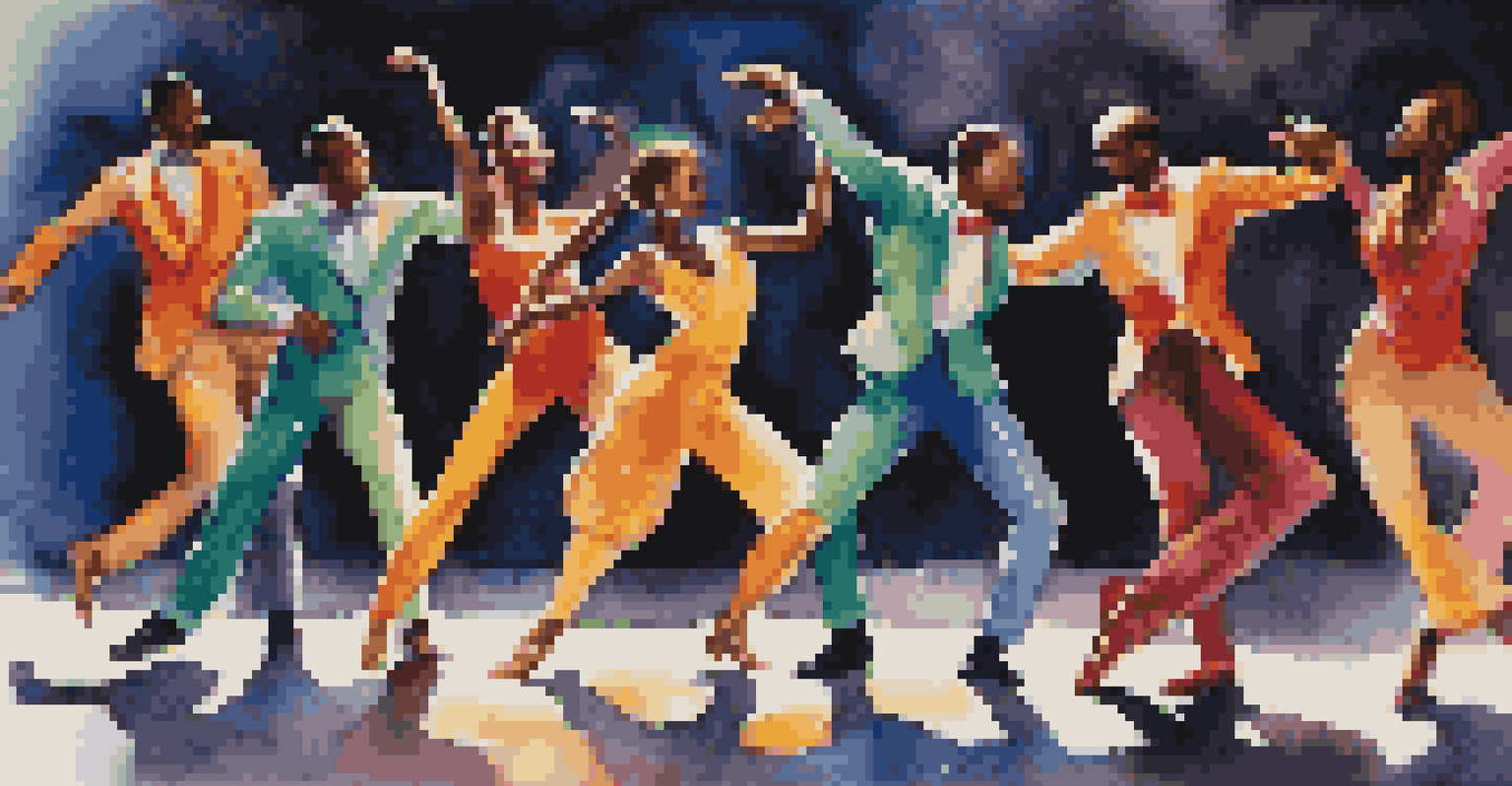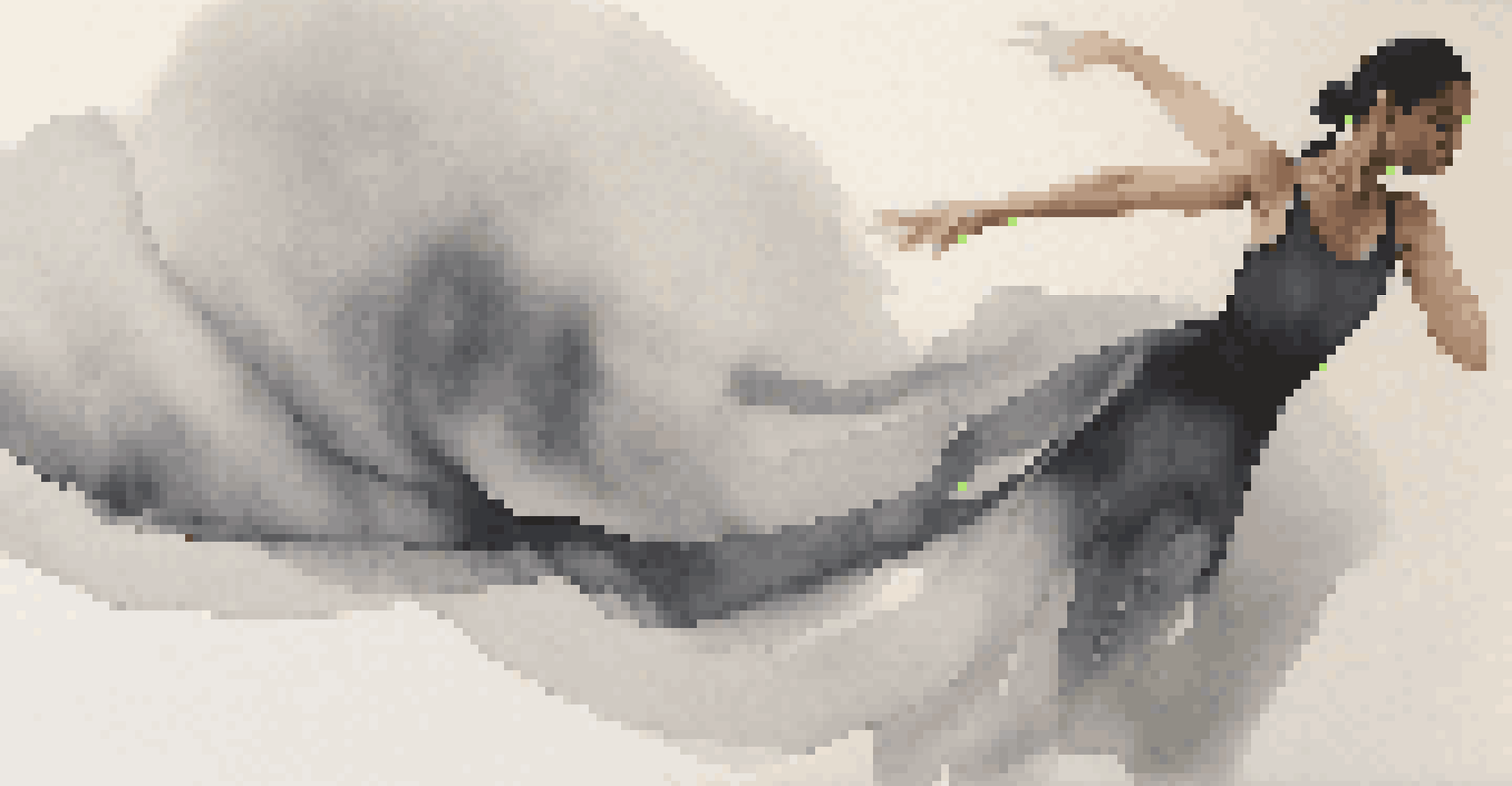The Evolution of Dance Styles Reflecting Emotional Narratives

Tracing the Roots of Dance: A Historical Perspective
Dance has been a fundamental part of human culture for centuries, serving as a means of storytelling and emotional expression. From ancient rituals to court dances, each style reflects the values and emotions of its time. For instance, traditional folk dances often convey community joy or sorrow, embodying the collective experiences of people.
Dance is the hidden language of the soul.
As societies evolved, so did their dance styles. The emergence of ballet in the Renaissance period marked a shift towards more structured forms of dance, emphasizing grace and poise while telling stories of love, loss, and ambition. This evolution showcases how dance adapts to reflect the emotional narratives that resonate within a culture.
Today, we see a blend of these historical influences in contemporary dance forms, highlighting the ongoing dialogue between past and present. This rich tapestry of styles allows dancers and audiences alike to connect with a wide range of emotions, reminding us of dance's power to transcend time and space.
The Role of Ballet: Emotion in Every Movement
Ballet, often seen as the epitome of classical dance, intricately weaves emotional narratives into its choreography. The expressive movements, combined with the dramatic music, create a profound connection between the dancers and their audience. Take 'Swan Lake,' for instance; the duality of the white and black swan embodies love and betrayal, encapsulating a deep emotional journey.

The precision and discipline of ballet serve as a powerful vehicle for conveying complex emotions. Dancers train for years to perfect their technique, allowing them to express feelings that words often cannot. This depth of expression is what makes ballet a timeless art form that continues to resonate with audiences across generations.
Dance Reflects Cultural Narratives
Each dance style embodies the emotional and cultural stories of its origins, allowing communities to express their identities.
Moreover, ballet has evolved to include modern influences, integrating contemporary themes and emotional narratives that reflect today’s societal issues. This fusion keeps the art form relevant, demonstrating that while techniques may change, the core emotional connection remains.
Jazz and the Expression of Individuality
Jazz dance emerged in the early 20th century as a celebration of individuality and personal expression. Rooted in African American culture, it reflects the emotions and experiences of its community, often conveying themes of joy, struggle, and resilience. The improvisational nature of jazz allows dancers to showcase their unique personalities, making each performance a personal narrative.
To watch us dance is to hear our hearts speak.
Unlike ballet's strict structure, jazz embraces freedom, encouraging dancers to express their emotions through movement. This style often incorporates elements of rhythm, syncopation, and playful gestures, inviting audiences to feel the energy and passion behind each performance. Think of the exuberance found in a jazz class or performance; it’s a vibrant conversation between the dancer and the music.
As jazz continues to evolve, it incorporates various influences, from hip-hop to contemporary dance, reflecting a broader emotional spectrum. This adaptability makes jazz a vital form of expression in today’s dance landscape, allowing individuals to connect their personal stories to a collective cultural narrative.
Contemporary Dance: A Canvas for Raw Emotion
Contemporary dance emerged in the mid-20th century as a reaction to the constraints of classical forms. It prioritizes emotional expression and personal narratives, often exploring themes of identity, mental health, and social issues. This genre allows dancers to convey raw emotions through fluid movements, often blurring the lines between dance and theatrical performance.
The beauty of contemporary dance lies in its versatility; it can incorporate elements from various styles, making it a rich platform for storytelling. For example, a contemporary piece may combine ballet's technical grace with the improvisational nature of jazz, creating a unique emotional experience for the audience. This fusion allows dancers to explore diverse narratives that resonate on multiple levels.
Ballet's Emotional Depth
Ballet intricately conveys complex emotions through its disciplined movements, creating a powerful connection with audiences.
Moreover, contemporary dance often emphasizes the importance of vulnerability. Dancers are encouraged to express their innermost feelings, breaking down barriers and inviting viewers to connect with their stories. This authenticity fosters a deeper emotional connection, reminding us that dance can be a powerful medium for sharing and understanding our shared human experiences.
Cultural Influences on Dance Styles and Emotions
Dance is deeply intertwined with culture, and each style often reflects the emotional narratives of its origins. For example, traditional dances from various cultures, such as the Hula from Hawaii or Flamenco from Spain, convey rich stories of love, loss, and celebration. These dances are not just performances; they are expressions of identity and heritage, allowing communities to share their emotions with the world.
As globalization continues to influence the dance landscape, we see a fascinating exchange of styles and emotions. Contemporary performers often blend cultural elements, creating hybrid forms that resonate with diverse audiences. This not only enriches the dance experience but also highlights the universal nature of emotions that transcends cultural boundaries.
However, it's essential to approach these cross-cultural influences with respect and understanding. Each dance style carries its own history and emotional weight, reminding us that while we can learn from one another, we must honor the narratives that shape these art forms. By appreciating the cultural roots, we deepen our connection to the emotional stories they tell.
Dance as a Reflection of Societal Changes
Throughout history, dance has served as a mirror to societal changes and emotional shifts. From the roaring twenties' jazz dances celebrating liberation to the powerful expressions of struggle seen in hip-hop, each dance style reflects the era's prevailing emotions. This dynamic relationship showcases how dance can articulate the collective psyche of a society during times of upheaval or joy.
In more recent years, contemporary dance has increasingly addressed social issues, from mental health to climate change, using movement as a powerful form of protest and awareness. Pieces like 'The Black Project' by the dancer and choreographer, Kyle Abraham, engage with themes of racial identity and personal experiences, creating a poignant dialogue with the audience. This demonstrates how dance can capture the zeitgeist and inspire change.
Contemporary Dance and Society
Contemporary dance acts as a mirror to societal changes, addressing themes like identity and social issues through emotional narratives.
As we move forward, the evolution of dance will likely continue to parallel societal changes, reflecting both the struggles and triumphs of the human experience. By engaging with these narratives, we not only honor the art form but also foster a deeper understanding of our shared emotions and histories.
The Future of Dance: Emotional Narratives in New Forms
As we look ahead, the future of dance promises to be as dynamic and emotionally rich as its past. With advancements in technology, we are beginning to see innovative ways that dance can be experienced, such as through virtual reality and digital performances. These new mediums offer unique opportunities for choreographers to tell their stories, reaching wider audiences and connecting on emotional levels that were previously unimaginable.
Moreover, the rise of social media platforms has transformed how dance is shared and perceived. Dancers can now showcase their emotional narratives globally, inviting diverse interpretations and connections. This democratization of dance allows for a fusion of styles and stories, creating a vibrant tapestry of human experience that reflects our collective emotions.

Ultimately, whatever the future holds, one thing remains certain: dance will continue to be a powerful form of emotional expression. By embracing innovation while honoring traditional narratives, the dance world will thrive, reminding us that movement has the power to connect us all, transcending barriers and fostering empathy in an ever-evolving society.